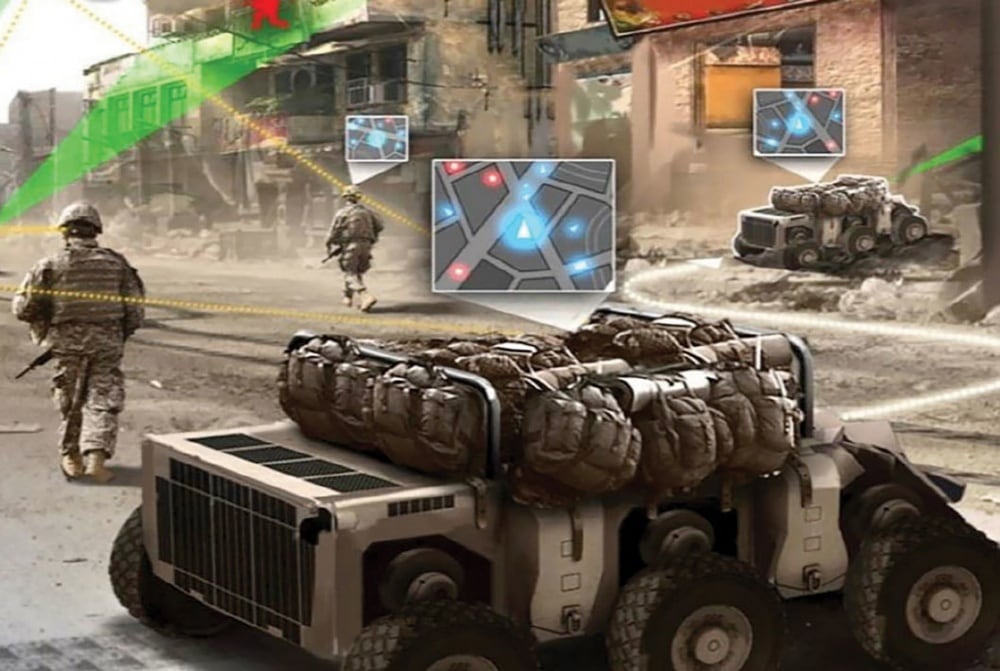As the Army integrates robots into its formations, from mule-like transports to single-soldier controlled drone swarms, it’s reaching out to industry and coming up with some novel solutions.
One such solution that was presented at a recent industry day at the Maneuver Center of Excellence at Fort Benning, Georgia, is an aerial drone mobile retrieval system that would help units get their drones back after missions without having to pause.
The “Talon,” made by Target Arm, was showcased to Army officials at this past week’s industry day, and it made an impression.
It uses a Venus Flytrap-like capture system on the back of a moving vehicle through which either a fixed-wing or rotary-wing drone can fly and be caught.
This gives troops a handy way to bring back valuable small drones, or drones of any size, really.
Don Sando, deputy to the MCoE commanding general, called it a “simple but elegant” solution to a problem units face when bringing back drone assets.
A key feature of the next fight, many Army officials have highlighted, is the ability for small, dispersed units to stay mobile so that they’re not tracked, sensed and targeted by enemy forces. And having a mobile retrieval system helps with that task.
RELATED

Work at the Maneuver Center of Excellence is ongoing, as it launched its robotics program and added to training for maneuver elements in the Army by incorporating robots at many levels.
In September, units such as the 101st Airborne Division and the 10th Mountain Division and Marines at Camp Lejeune, North Carolina, are set to begin testing the Squad Multipurpose Equipment Transport.
The SMET saw trials of 10 submissions at MCoE before being down selected to four that have been designated for the combat arms units.
Those include: the MRZR X, based off the Polaris MRZR currently in service with the Marines; the General Dynamics 4x4 Multi-Utility Tactical Transport or MUTT; the Howe and Howe RS2-H1; and the HDT Global Hunter WOLF, or Wheeled Offload Logistics Follower.
The vehicle must carry enough gear for a nine-soldier squad — nine rucks, two fuel jugs, two water jugs and three days’ worth of Meals, Ready to Eat — as well as carry batteries and charge them while on mission.
It must also carry 1,000 pounds, travel 60 miles in 72 hours, and charge up at a 3-kilowatt rate while stationary and a 1-kilowatt rate while moving
Army officials are expected to decide on which SMET submission of the four being evaluated will be selected by early 2020.
Simultaneously, Sando said that work is ongoing with the common controller, which is a universal controller that the Army wants for controlling both air and ground robots. Such a controller would help with training and consistency across the units using such devices.
And that controller is an important piece of equipment leading into stages of robot development.
“The first initiative is to get one soldier to operate more than one robotic system,” Sando said.
But that’s only the beginning.
“One soldier, one robot is interesting,” Sando said. “Several dozen is completely different.”
The step after that is systems operating systems, officials said.
Timelines haven’t quite been defined for single-soldier robot swarm controlling efforts, but they might become clearer once the Department of Defense and other higher echelon entities make the Robot Autonomous Systems Initial Operating Concept document official.
The blueprint for how the Army will pursue and integrate such systems into the force will help with developing common architecture and standards so that systems work uniformly for their users, future developers and with each other.
Todd South has written about crime, courts, government and the military for multiple publications since 2004 and was named a 2014 Pulitzer finalist for a co-written project on witness intimidation. Todd is a Marine veteran of the Iraq War.




